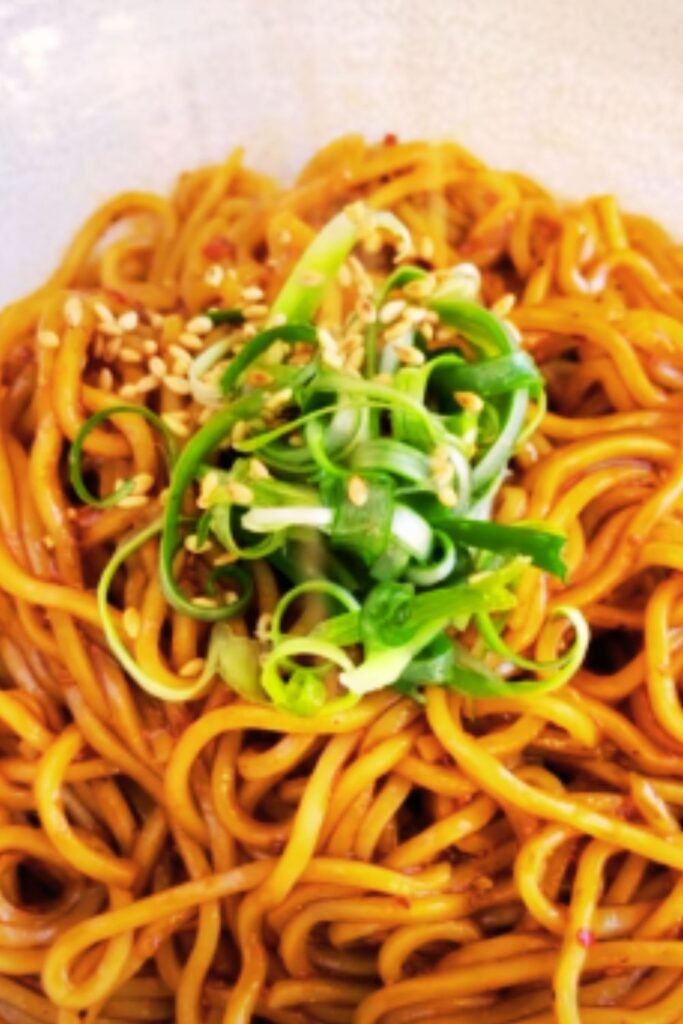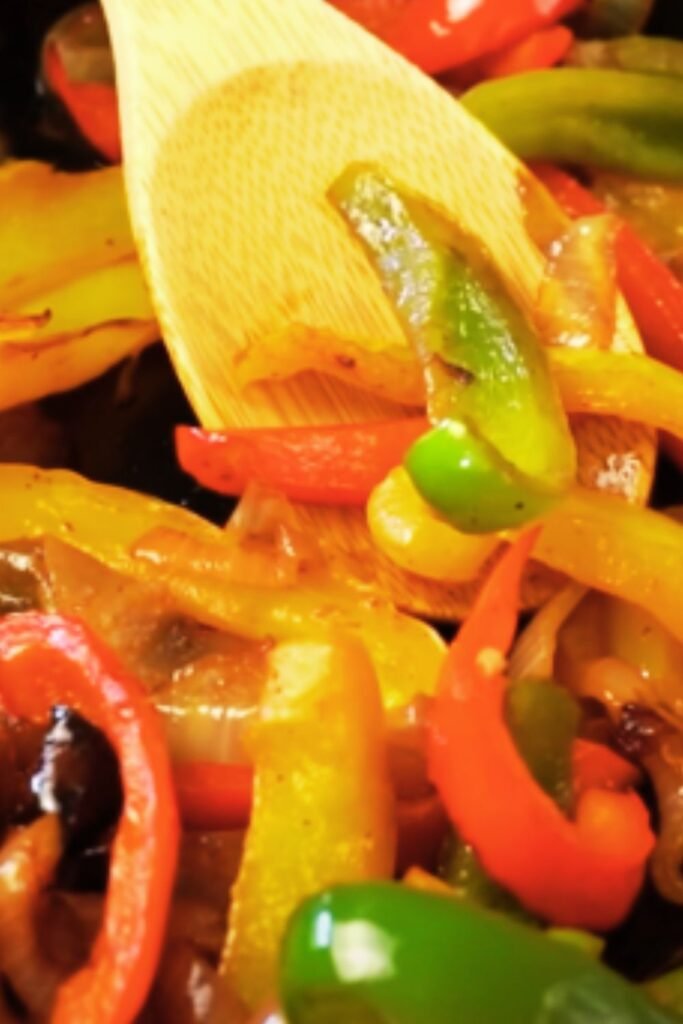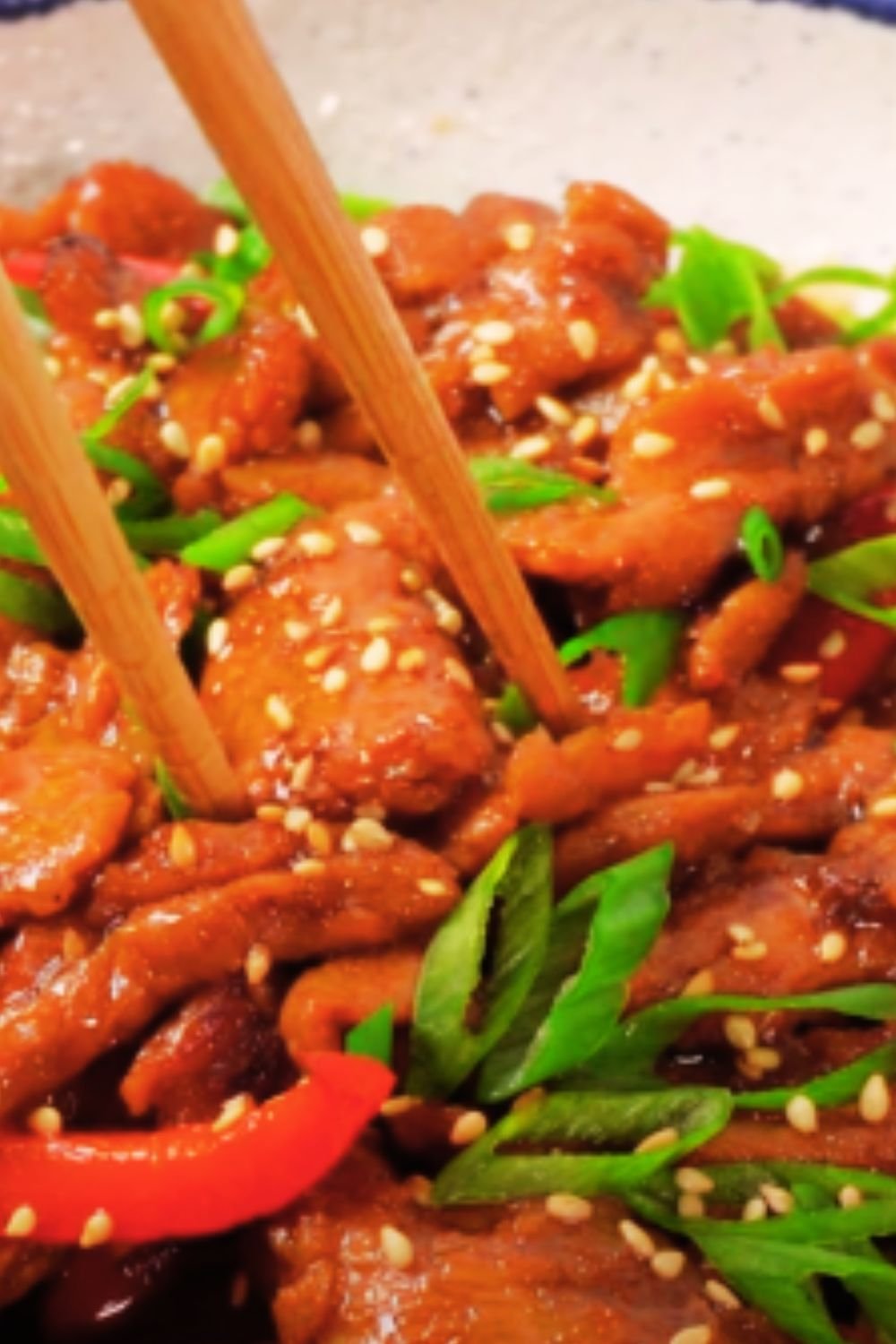When I first discovered plant-based cooking, I thought I’d have to give up all my favorite Chinese takeout dishes. Boy, was I wrong! This vegan garlic pepper “beef” stir-fry has become my go-to recipe when I’m craving something savory, satisfying, and authentically Chinese in flavor. The combination of tender plant-based protein, aromatic garlic, and that signature peppery kick creates a dish that rivals any traditional version.
What makes this recipe truly special is how it captures the essence of classic Chinese stir-frying techniques while being completely plant-based. I’ve spent countless hours perfecting this recipe, and I can confidently say it delivers on both taste and texture. The “beef” develops a beautiful sear, the vegetables retain their crisp bite, and every component harmonizes in that perfect balance of salty, spicy, and umami flavors.
Understanding the Magic Behind Chinese Stir-Frying
Before diving into the recipe, let me explain what makes Chinese stir-frying so unique and how we can achieve authentic results with plant-based ingredients.
Wok Hei: The breath of the wok This untranslatable Chinese term refers to the distinctive smoky flavor that comes from cooking over extremely high heat in a well-seasoned wok. While most home kitchens can’t replicate restaurant-level heat, I’ll show you techniques to get as close as possible.
Velvet Texture: The secret to tender protein Traditional Chinese cooking uses a technique called velveting to create incredibly tender meat. My plant-based version uses cornstarch coating and precise timing to achieve similar results.
Balanced Seasonings: The foundation of flavor Chinese cuisine relies on balancing five key flavors: sweet, sour, salty, spicy, and umami. This recipe demonstrates how to achieve this balance using vegan ingredients.
High Heat Cooking: The key to crisp vegetables Stir-frying requires intense heat and constant movement to cook ingredients quickly while maintaining their texture and nutritional value.
Choosing Your Plant-Based “Beef”
The protein choice can make or break this dish. After testing numerous options, I’ve identified the best alternatives that provide the right texture and flavor absorption.
| Plant-Based Protein | Texture | Flavor Absorption | Cooking Time | Best For |
|---|---|---|---|---|
| Seitan (homemade) | Chewy, meat-like | Excellent | 3-4 minutes | Authentic texture lovers |
| Store-bought seitan strips | Firm, consistent | Good | 2-3 minutes | Convenience seekers |
| Soy curls (rehydrated) | Fibrous, shredded | Outstanding | 4-5 minutes | Natural ingredient fans |
| King oyster mushrooms | Meaty, substantial | Moderate | 5-6 minutes | Whole food enthusiasts |
| Firm tofu (pressed) | Tender, mild | Good | 3-4 minutes | Budget-conscious cooks |
| TVP (textured vegetable protein) | Chewy, versatile | Excellent | 2-3 minutes | Protein seekers |
My personal favorite is homemade seitan because it provides the most authentic chew and readily absorbs the marinade flavors. However, soy curls are a close second for their natural texture and incredible flavor absorption.

Essential Ingredients and Their Roles
The Protein Marinade Components
Dark Soy Sauce: Provides deep color and rich umami flavor. I prefer brands like Lee Kum Kee or Pearl River Bridge for authentic taste.
Light Soy Sauce: Adds saltiness without overwhelming color. This creates the base salinity for the protein.
Shaoxing Wine: Traditional Chinese cooking wine that adds complexity. Substitute with dry sherry if unavailable.
Cornstarch: Creates the velveting effect and helps develop a beautiful golden crust during cooking.
White Pepper: More aromatic and less harsh than black pepper, essential for authentic Chinese flavor.
The Aromatics Foundation
Fresh Garlic: The star ingredient that should be minced just before cooking to preserve its pungent oils.
Fresh Ginger: Provides warmth and helps balance the garlic’s intensity.
Scallions: Both white and green parts serve different purposes – whites for cooking, greens for garnish.
The Sauce Symphony
Creating the perfect sauce requires understanding how each ingredient contributes to the final flavor profile.
| Ingredient | Amount (per 4 servings) | Flavor Contribution | Purpose |
|---|---|---|---|
| Dark soy sauce | 2 tablespoons | Deep umami, color | Base flavor |
| Light soy sauce | 1 tablespoon | Clean saltiness | Seasoning balance |
| Oyster sauce (vegan) | 2 tablespoons | Sweet umami richness | Depth and gloss |
| Shaoxing wine | 1 tablespoon | Floral complexity | Aroma enhancement |
| Sugar | 1 teaspoon | Subtle sweetness | Flavor balance |
| Cornstarch | 1 teaspoon | Thickening | Sauce consistency |
| Sesame oil | 1/2 teaspoon | Nutty finish | Aromatic accent |
| White pepper | 1/4 teaspoon | Sharp heat | Spice foundation |
| Black pepper | 1/8 teaspoon | Pungent warmth | Additional heat layer |
Step-by-Step Cooking Process
Preparation Phase (Mise en Place)
I cannot stress enough how crucial preparation is for successful stir-frying. Everything happens quickly once you start cooking, so having ingredients ready is essential.
Protein Preparation (20 minutes before cooking): Cut your chosen plant-based protein into uniform strips about 1/4 inch thick and 2 inches long. Consistent sizing ensures even cooking. In a bowl, combine the protein with 1 tablespoon dark soy sauce, 1/2 tablespoon light soy sauce, 1 tablespoon Shaoxing wine, and 1 tablespoon cornstarch. Mix thoroughly and let marinate while preparing other ingredients.
Vegetable Preparation: I like to include bell peppers for sweetness and crunch, onions for depth, and sometimes snap peas for additional texture. Cut everything into similar-sized pieces to ensure uniform cooking.
Sauce Mixing: Combine all sauce ingredients in a small bowl and whisk until the cornstarch completely dissolves. This prevents lumpy sauce and ensures smooth incorporation.
The Cooking Sequence

Step 1: Heat Management Heat your wok or large skillet over the highest heat your stove can provide. Add 1 tablespoon of neutral oil with a high smoke point (peanut or avocado oil work best). The oil should shimmer and almost smoke.
Step 2: Protein Searing Add the marinated protein in a single layer. This is crucial – don’t overcrowd or the protein will steam instead of sear. Let it cook undisturbed for 45-60 seconds until the bottom develops a golden crust. Flip and sear the other side for another 45 seconds. Remove and set aside.
Step 3: Aromatics Building In the same wok, add another teaspoon of oil if needed. Add minced garlic and ginger, stir-frying for 15-20 seconds until fragrant but not browned. The key is releasing the aromatics without burning them.
Step 4: Vegetable Cooking Add harder vegetables first (onions, bell peppers), stir-frying for 1-2 minutes. Then add softer vegetables (snap peas, bean sprouts) for another 30-60 seconds. Vegetables should be crisp-tender, not soft.
Step 5: Final Assembly Return the protein to the wok, give the sauce a quick stir (cornstarch settles), and pour it over everything. Stir constantly for 30-60 seconds until the sauce thickens and coats all ingredients. Remove from heat immediately.
Step 6: Finishing Touches Sprinkle with freshly ground black pepper, chopped scallion greens, and a final drizzle of sesame oil.
Nutritional Benefits and Analysis
| Nutrient | Per Serving | % Daily Value | Health Benefits |
|---|---|---|---|
| Protein | 18-22g | 36-44% | Muscle maintenance, satiety |
| Fiber | 4-6g | 16-24% | Digestive health, blood sugar control |
| Iron | 3-4mg | 17-22% | Oxygen transport, energy production |
| Vitamin C | 45-60mg | 50-67% | Immune support, collagen synthesis |
| Folate | 40-50mcg | 10-13% | Cell division, DNA synthesis |
| Potassium | 350-400mg | 7-9% | Heart health, blood pressure regulation |
| Sodium | 800-1000mg | 35-43% | Electrolyte balance (moderate intake) |
This dish provides complete nutrition while being lower in saturated fat and cholesterol-free compared to traditional beef versions. The combination of plant proteins offers all essential amino acids when paired with rice or other grains.
Mastering the Perfect Texture
Achieving restaurant-quality texture at home requires understanding a few key principles that I’ve learned through trial and error.
Temperature Control: Your pan must be screaming hot. I often preheat my wok for 2-3 minutes on high heat before adding oil. If you hear vigorous sizzling when ingredients hit the pan, you’re on the right track.
Timing Precision: Stir-frying is about seconds, not minutes. Overcooking by even 30 seconds can turn crisp vegetables into mushy disappointments. I recommend timing each step with a kitchen timer until you develop an intuitive sense.
Moisture Management: Excess moisture is the enemy of good stir-frying. Always pat vegetables dry after washing, and don’t add sauce until the very end to prevent steaming.
Movement Technique: Use a spatula or wok spatula to constantly toss and flip ingredients. The goal is to keep everything moving so each piece gets equal exposure to the hot surface.
Flavor Variations and Customizations
After making this recipe hundreds of times, I’ve developed several variations that keep things interesting.
Sichuan Style: Add 1/2 teaspoon of Sichuan peppercorns (ground) and 1-2 dried chilies for that distinctive numbing heat.
Mongolian Influence: Include sliced onions and a touch of hoisin sauce for sweetness reminiscent of Mongolian “beef.”
Cantonese Approach: Keep it simple with just ginger, scallions, and high-quality soy sauce to let the ingredients shine.
Hunan Heat: Incorporate fresh chilies and chili oil for those who love serious spice.
Serving Suggestions and Pairings

This stir-fry pairs beautifully with various accompaniments that complement its bold flavors.
Rice Varieties:
- Jasmine rice for its floral aroma
- Brown rice for added nutrition and nuttiness
- Forbidden black rice for dramatic presentation
- Coconut rice for subtle sweetness
Noodle Options:
- Fresh lo mein noodles
- Rice noodles for gluten-free needs
- Shirataki noodles for low-carb diets
Additional Sides:
- Steamed bok choy with garlic
- Chinese cucumber salad for cooling contrast
- Hot and sour soup as a starter
- Vegetarian spring rolls for crunch
Storage and Meal Prep Tips
This dish is excellent for meal preparation, though proper storage techniques ensure the best reheating results.
Refrigeration: Store in airtight containers for up to 4 days. Keep sauce-heavy portions separate from plain rice to prevent sogginess.
Freezing: The cooked stir-fry freezes well for up to 3 months. Portion into individual servings for convenient defrosting.
Reheating Methods:
- Wok reheating: Best results, restores some crispness
- Microwave: Quick but may soften vegetables
- Oven: Cover with foil at 350°F for 10-12 minutes
Troubleshooting Common Issues
| Problem | Cause | Solution |
|---|---|---|
| Soggy vegetables | Heat too low, overcrowding | Higher heat, smaller batches |
| Tough protein | Insufficient marinating, overcooking | Longer marinade time, precise timing |
| Bland flavor | Inadequate seasoning, poor sauce balance | Taste and adjust, proper sauce ratios |
| Sauce too thin | Insufficient cornstarch, not enough cooking | More cornstarch slurry, longer cooking |
| Burnt garlic | Oil too hot, garlic added too early | Medium-high heat, add after oil cools slightly |
| Uneven cooking | Inconsistent cutting, improper technique | Uniform cuts, proper stir-fry motion |
The Science Behind Flavor Development
Understanding the science helps you become a better cook. The Maillard reaction occurs when proteins and sugars react under high heat, creating complex flavors and appealing colors. This is why proper searing of the plant-based protein is so crucial.
The cornstarch coating on the protein serves multiple purposes: it protects against overcooking, aids in browning, and helps the sauce adhere better. When heated, cornstarch forms a protective barrier that keeps the interior tender while the exterior develops flavor.
White pepper’s unique flavor comes from different processing than black pepper. The outer layer is removed, resulting in a cleaner, more aromatic heat that doesn’t overpower the dish’s other flavors.
Questions and Answers
Q: Can I make this dish without a wok? A: Absolutely! While a wok is ideal due to its shape and heat distribution, a large skillet or sauté pan works well. The key is using the highest heat possible and not overcrowding the pan.
Q: What’s the best substitute for Shaoxing wine? A: Dry sherry is the closest substitute, but you can also use Japanese sake or even white wine in a pinch. Avoid sweet cooking wines as they’ll alter the flavor balance.
Q: How can I make this dish less salty? A: Reduce the soy sauce quantities and add more vegetables to dilute the saltiness. You can also rinse the plant-based protein before marinating if it’s particularly salty.
Q: Is this recipe gluten-free? A: It depends on your protein choice and soy sauce. Use tamari instead of soy sauce and ensure your plant-based protein is gluten-free. Many seitan products contain wheat gluten.
Q: Can I prep ingredients ahead of time? A: Yes! You can marinate the protein and chop vegetables up to 24 hours in advance. Store them separately in the refrigerator and bring to room temperature before cooking.
Q: Why does my stir-fry turn out watery? A: This usually happens when vegetables release moisture during cooking. Make sure your pan is hot enough, don’t overcrowd, and pat vegetables dry after washing.
Q: How do I know when the protein is properly seared? A: Look for a golden-brown crust that doesn’t stick to the pan when you try to flip it. If it sticks, give it another 15-30 seconds before attempting to turn.
Q: Can I double this recipe? A: I recommend cooking in two batches rather than doubling everything at once. Overcrowding leads to steaming instead of proper stir-frying, which compromises texture and flavor.
This garlic pepper “beef” stir-fry has become one of my most requested recipes, and I hope it brings as much joy to your kitchen as it has to mine. The combination of traditional techniques with modern plant-based ingredients creates something truly special – a dish that satisfies cravings while aligning with conscious eating choices. Remember, great stir-frying is about confidence, timing, and high heat. Once you master these elements, you’ll be creating restaurant-quality dishes in your own home.


